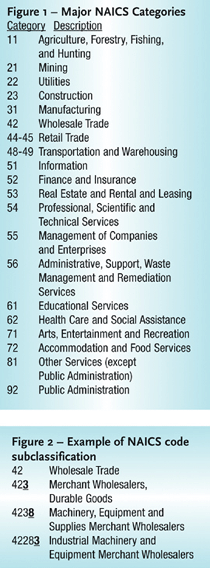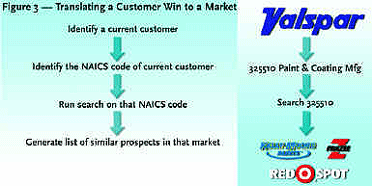Distributors who seek new customers often wonder how to generate a list of prospects. Industry classification systems can be an effective tool to help distributors focus their selling efforts in market segments they already serve, or introduce their capabilities to companies in similar industries.
The government established industry classification systems to organize industries into more definable categories. In the U.S., the Census Bureau traditionally used the Standard Industrial Classification (SIC) system. When Congress passed the North American Free Trade Agreement (NAFTA), the U.S., Canada and Mexico jointly developed a newer system called the North American Industry Classification System (NAICS). Regardless of the system type, industry classifications can be an effective method for extracting industry information and generating prospect lists.

Typically, an industry classification system uses broad categories for industries that are then subdivided into narrower definitions. The NAICS System uses 10 major categories.
Each major category is broken into subcategories that refine the definition more specifically. For example, in Figure 2, Industrial Equipment Distributors (NAICS 42383 - Industrial Machinery and Equipment Merchant Wholesalers) are shown as a sub-category of the NAICS 42 - Wholesale Trade.
Let's say a distributor has a very good customer, Valspar Paint. Naturally, that company may want to find similar prospects in that industry to sell their products and services. The company could use the NAICS or SIC system to generate an extensive list of prospects in the same industry as Valspar.

A variety of information service providers can perform this type of query for a fee, but it's typically a reasonable amount to pay to get started on developing a more targeted approach to seeking prospects. Companies that offer lists include Dun & Bradstreet (www.dnb.com), Hoovers (www.hoovers.com), InfoUSA (www.infousa.com), Moody's Investor Service (www.moodys.com), Standard & Poor's (www.standardandpoors.com), and HarrisInfoSource (www.HarrisInfo.com). Interlynx Systems can run queries for clients and also provide customer evaluation service based on this process (see the free offer at the end of this article).
After developing a prospect list, the company should identify and document key selling points. In the paint industry example, the seller should document the reasons they were successful at Valspar, whether it was product performance, service or any other selling point. Testimonials or a reference from Valspar also demonstrate the seller's competence to similar customers.
Companies can take these selling points and draft them into market scripts to share across the selling network, especially when the industry is national or global in scope. This is an excellent way for distributors and manufacturers to collaborate in the market place. The scripts could include industry background information, information on the types of products and services you provide, competitive comparisons and a testimonial from a customer. A good script will help the distributor sell on value and customer needs, not price.
Once you identify a target industry, generate a prospect list, and create a market script, it is critical to assign the target accounts to a responsible sales team member for sales follow-up.
Distributors or representative organizations are ideal for this because of the number of "feet on the street" they represent. A distributor with a team of six salespeople calling on four prospects each can focus on 24 new sales prospects. Armed with a solid market script, the distribution network will drive focused and comprehensive selling that is unmatched by a direct sales model. Manufacturers that understand this can drive dramatic market share growth.
Industry classification systems can be an effective way to drive lists of market-specific prospects. Combined with a market-focused script and a distributor network, you too can drive higher profitable sales!
The government established industry classification systems to organize industries into more definable categories. In the U.S., the Census Bureau traditionally used the Standard Industrial Classification (SIC) system. When Congress passed the North American Free Trade Agreement (NAFTA), the U.S., Canada and Mexico jointly developed a newer system called the North American Industry Classification System (NAICS). Regardless of the system type, industry classifications can be an effective method for extracting industry information and generating prospect lists.

Typically, an industry classification system uses broad categories for industries that are then subdivided into narrower definitions. The NAICS System uses 10 major categories.
Each major category is broken into subcategories that refine the definition more specifically. For example, in Figure 2, Industrial Equipment Distributors (NAICS 42383 - Industrial Machinery and Equipment Merchant Wholesalers) are shown as a sub-category of the NAICS 42 - Wholesale Trade.
Driving new business through market focus
Using an industry classification system for prospecting is a great way to identify target accounts. As a company becomes more market focused, it can begin to leverage its understanding of a given market into a strategic market approach.Let's say a distributor has a very good customer, Valspar Paint. Naturally, that company may want to find similar prospects in that industry to sell their products and services. The company could use the NAICS or SIC system to generate an extensive list of prospects in the same industry as Valspar.

A variety of information service providers can perform this type of query for a fee, but it's typically a reasonable amount to pay to get started on developing a more targeted approach to seeking prospects. Companies that offer lists include Dun & Bradstreet (www.dnb.com), Hoovers (www.hoovers.com), InfoUSA (www.infousa.com), Moody's Investor Service (www.moodys.com), Standard & Poor's (www.standardandpoors.com), and HarrisInfoSource (www.HarrisInfo.com). Interlynx Systems can run queries for clients and also provide customer evaluation service based on this process (see the free offer at the end of this article).
After developing a prospect list, the company should identify and document key selling points. In the paint industry example, the seller should document the reasons they were successful at Valspar, whether it was product performance, service or any other selling point. Testimonials or a reference from Valspar also demonstrate the seller's competence to similar customers.
Companies can take these selling points and draft them into market scripts to share across the selling network, especially when the industry is national or global in scope. This is an excellent way for distributors and manufacturers to collaborate in the market place. The scripts could include industry background information, information on the types of products and services you provide, competitive comparisons and a testimonial from a customer. A good script will help the distributor sell on value and customer needs, not price.
Once you identify a target industry, generate a prospect list, and create a market script, it is critical to assign the target accounts to a responsible sales team member for sales follow-up.
Distributors or representative organizations are ideal for this because of the number of "feet on the street" they represent. A distributor with a team of six salespeople calling on four prospects each can focus on 24 new sales prospects. Armed with a solid market script, the distribution network will drive focused and comprehensive selling that is unmatched by a direct sales model. Manufacturers that understand this can drive dramatic market share growth.
Industry classification systems can be an effective way to drive lists of market-specific prospects. Combined with a market-focused script and a distributor network, you too can drive higher profitable sales!
